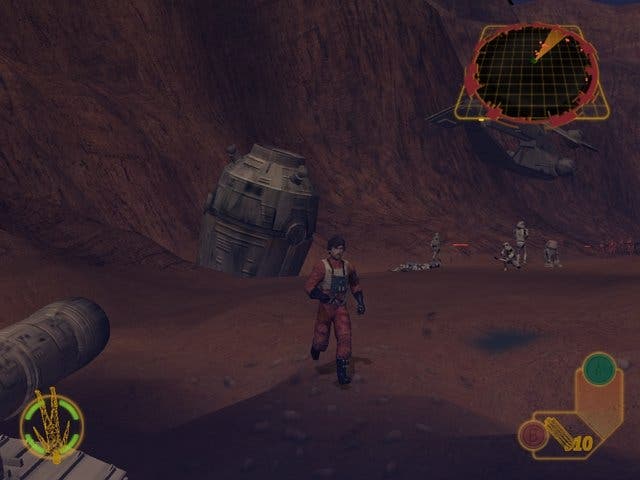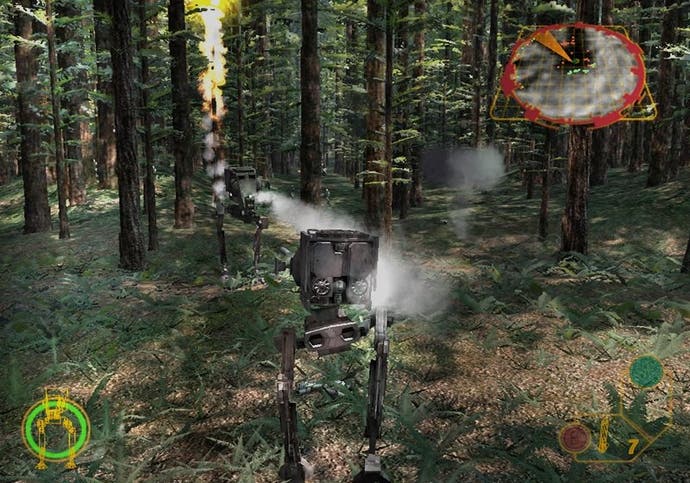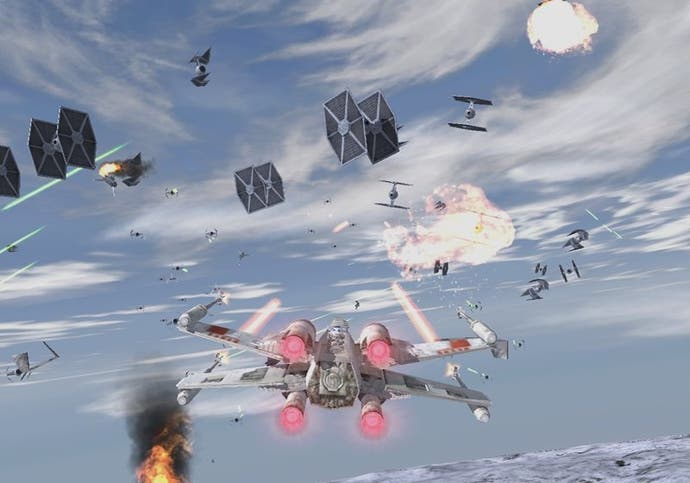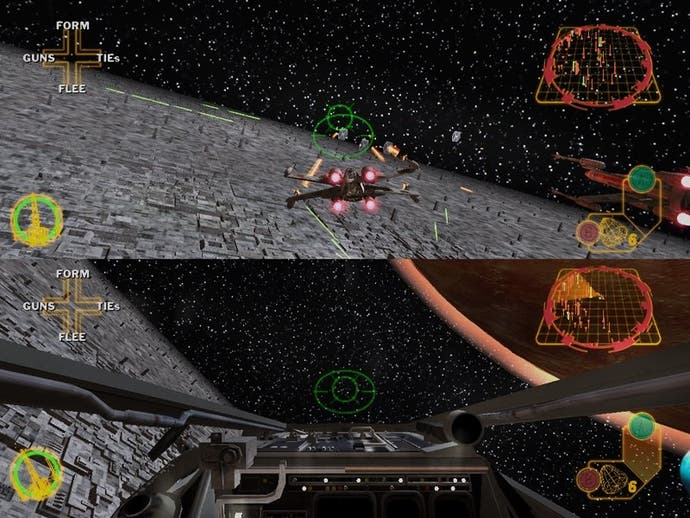Star Wars Rogue Squadron III: Rebel Strike
Can Factor 5 reclaim their rogue leadership?
It's 5pm on November 5th and I'm driving home from the movies. Having taken the afternoon off to watch the disappointing conclusion of an epic movie trilogy, I'm left thinking that this doesn't compare to what came before, that the directors have lost sight of what made the first film so special, and that the subsequent events they've dreamt up are largely superfluous and unfulfilling. I'm disappointed, but I did find the experience vaguely compelling, so it wasn't a complete waste of time.
24 hours later, it's 5pm on November 6th and I'm in the grip of déjà vu. As I sit on my couch reflecting on an afternoon with Rebel Strike, the third film-based shoot-'em-up of the Rogue Squadron series, I feel pretty much the same way I did the previous evening. It's been a week for hugely disappointing, yet occasionally compelling forms of third-generation entertainment.
Size matters not

When Rogue Leader first appeared on the GameCube, there were very few who stood against it. From the fans, who loved the way it bound the feel of the original and best Star Wars films to a tough but gripping series of space combat missions, to its competitors at the system's launch, which largely turned out to be over-priced, under-appreciated or cynically rehashed. However as Rebel Strike arrives today, it's brushing shoulders with all manner of top Cube titles (Mario Kart is due out next week for goodness sake), and, as developer Factor 5 openly admits in an unlockable documentary on the game disc, when it started out it wasn't really sure what to do. Largely because, give or take a few standout moments in Rebel Strike, the series should have ended with the phenomenally complete Rogue Leader, as players dived into the core of the second Death Star and dealt the Empire a mortal wound from which it would never recover. Maybe someone should have borrowed an X-Wing and flown it into Factor 5 to stop it soiling its legacy.
The main problem with Rebel Strike is the shift in focus. In the period since Rogue Leader shipped, Factor 5 has rebuilt its graphical engine, which still looks absolutely stunning, and spent the remaining time labouring over what are largely ground-based missions. Over the course of the game, Luke Skywalker and buddy Wedge will spend the majority of their time on foot in a grossly under-developed third-person action game, occasionally piloting vehicles ranging from Luke's Tatooine hover car thing and the speeders from the forests of Endor to Imperial walkers and even those furry snow creatures from the beginning of Empire, but mostly pointing the analogue stick in the direction of the nearest incompetent enemy (of which there are loads) and mashing the A button for all it's worth. When Rebel Strike does occasionally deviate into space it is at its strongest, introducing some exciting new ships - a nippy Imperial model unlocked late on was our favourite, and one mission also lets you play around with the best weapon seen in Episode II, the sonic charges Jango Fett used to attack Obi-Wan's Jedi Starfighter - and throwing around some of the game's most impressive sights and sounds. It's just a shame that, for the most part, the developer seems happier to pad it out with the unexciting, unfamiliar and poorly put together ground-based missions.
It's also surprisingly easy. I was actually able to complete every single-player mission in the game - many to silver and even gold medal standard - in just one evening of relatively hardcore play. Although I've only returned to Rogue Leader a few times since the Cube's launch, I distinctly remember a lot more swearing, a lot more effort, and a lot more fun. Like the other big sequel I reviewed this week, fans of the series are going to zip through this like a lightsabre through Darth Maul.
Mash the A button, Luke

Getting back to those ground missions though, it's agonising to actually play them. Not specifically because it's hard or unfair or anything like that (although you might say that on a number of occasions), but because the game spends most of the time looking utterly stunning, easily on a par with its luscious predecessor, and it's this that prompts you to wonder how good it could have been. As it is, the beautifully textured and intricately constructed environments in Rebel Strike - from the grand halls and rough, ready furnishings of the Yavin IV Rebel base to the shiny, reflective and highly detailed confines of the original Death Star - are the best part of the game, but they're derailed by characters and enemies who noticeably slide along the ground as they walk, peculiar movement animations (doing a 360 degree spin on the analogue stick has Luke pivoting oddly on his back foot) and terrible camera placement.
Although a few missions place the camera over your shoulder, most of the game places the camera for you, often switching perspectives at inopportune moments, or hiding enemies off the screen below the camera's line of sight. And of course when it does follow you, you have no direct control (the C-stick being used to perform throwaway actions like opening doors), so it swoops around oddly depending on the direction you're running. Hugely frustrating to deal with.
It doesn't help that when you're on foot the game is so unchallenging and simple as to be totally unfulfilling. Combat is, as I've said, just a case of running at an enemy while mashing the A button. You have the option of using a few thermal detonators, and occasionally you can put them to good use by wiping out a group of huddled enemies, but for the most part it's just point, mash, point, mash, as quick as you can because the game rewards haste and accuracy with a better medal. You can lock on with the left trigger and potentially circle strafe enemies, but it's a pointless exercise because most of them crumple in two or three shots. Those that don't, like the final boss, are just a case of mashing A for as long as possible and trying to avoid anything they fire back at you, which is rarely much of note. There's no strategy or thought in these battles at all. I don't care if it's meant to be "arcadey" and "accessible" - it can be both of these things all it wants, but if it's rubbish to play then that's what counts.
I find its lack of fun disturbing

The best example of this on-foot rubbishness actually pops up right at the end of the game, but I don't feel too guilty recounting the experience here because a) it's absolutely rubbish to play, b) you've all seen the films so know exactly what happens, and c) it epitomises everything that's wrong with Rebel Strike. Welcome, then, to "Trials of the Jedi", a mission charting Luke's meeting with Yoda on the swamp planet Dagobah and filling in the gaps between when he arrives a stupid, hot-tempered wretch with a laser and no belief, to when he leaves as a learned almost-Jedi preparing to face his evil father in the crucible of the next big Death Star bang.
As with many missions in the game, it mixes footage from the first three films (here, Empire) with in-game cut sequences and gameplay sections. It's a terrible pastiche of games like Lord of the Rings: The Two Towers, which served as loving companions to the films their developers so rightly revered, but that's not the worst bit - the worst bit is actually playing it. Obviously now Luke finally gets his hands on a lightsabre (for the first time in the game), the player expects a bit of combat - perhaps that weird, dreamy showdown with Vader in the stump of a tree, but in typical Rebel Strike style, it's a total cop out. Luke is taught how to hold B to deflect laser blasts (gosh) and then shown how to double-jump by pressing X twice (golly gosh), and his path to Jedi-hood thenceforth consists of 2D (yes, 2D) platforming sections involving floating rocks, James Bond-style leaps between the backs of swamp creatures and clobbering spider enemies and their little igloo-style huts with the lightsabre. Absolute pish.
Super Return of the Jedi on the Super Nintendo is a far finer 2D platform Star Wars game. At least in that you didn't find the collision detection throwing you off rocks and into the water (instant death), invisible objects in the air blocking your jumps (see previous brackets), and slow-moving rocks which seem to be operating on a conveyor belt didn't run into you (er, again...). What's more, I certainly don't remember a finale involving button-mashing the tiny B button to lift the X-Wing out of the swamp. Fail to get it up to a certain height and it slumps back down (instant Mission Failed screen, requiring the repetition of all the crap beforehand), and yet if you do get it to a certain point, it sinks down anyway and Luke utters his famous defeatist words about it being too hard, before a snippet of film takes over and shows Yoda lifting the craft to safety. Victory, apparently. Trials of the Jedi is, without question, the worst mission in Rebel Strike.
No match for a good blaster, kid

Surely that's it though? Surely this is where I turn around and say "on the other hand" and start raving about the good bits? No. No it is not. I'm far from done ripping into this one. Let's move on, shall we, to the walker missions? These take place at a number of points in the game, and comprise most of the gameplay in the final, end credits-prompting sequence at the culmination of Return of the Jedi. Control is... a bit fiddly, with the R button moving the walker forward (it can't go backwards), the analogue stick for turning and A for laser fire. Missions generally consist of targeting other walkers, laser gun emplacements and the odd flying enemy. There's nothing especially bad about these sections (although walkers are pretty slow and cumbersome, and regularly get caught on trees and other bits of scenery), but then there's nothing especially good about them. I suppose the fact that they indirectly serve up one of the game's highlights - wingmen controls that allow you to deploy Ewok traps like rolling logs, catapults and flying logs against other walkers - should count for something, but to be honest it doesn't raise more than a wry smile, and their overuse quickly puts pay to that.
Then there are the other vehicles and diversions -Taun-Tauns, which move like motorbikes on ice and only pop up for about ten seconds anyway, the larger Imperial walkers, which pop up once for a tedious, on-rails shoot-'em-up section, and the Imperial speeders, which are actually fun to pilot by virtue of being ludicrously fast and a prime target for other speeders (in a beautiful, Road Rash-style mission racing through the forests of Endor), probe droids and even, in a memorable mountain top pursuit, TIE Bombers. But these positives are things I struggled to remember as I found myself bogged down by horrible memories of the bits that I most hated - the way the game shoehorns key elements of the film into throwaway moments and then saturates levels with them, like the bit where Luke grapple-hooks his way up to the underbelly of an Imperial walker, slashes his way inside and chucks in a thermal detonator; the analogue controls on the stationary/on-rails shoot-'em-up sections, with a targeting reticule that zips back to centre unless you hold the stick precisely in place at a certain angle; and the speeder/walker/tow cable sections, which involve pressing B, rotating round the legs a bit while trying not to die at the hands of the camera, and then watching the rope slip down and the walker perish unconvincingly.
I simply don't have the time or inclination to keep banging on about these aspects, as I'd like to get onto the space combat sometime before Christmas, but it would be foolish of me not to mention some of the other problems I've encountered: annoyingly long fades and wipes as the game sits and loads the next badly inserted sequence of film footage; a three-life system in a game which generally only takes three or four lives per level to get through on the first try (very cynical); a terrible, half-hour-long tutorial devoid of entertainment or value; and mission briefings which are often muffled at you via voice (we sometimes had to look them up on the net) or are just plain ambiguous to begin with. Oh, and the game actually crashed on me. Twice.
Adventure? Heh. Excitement? Nah.

Finally then, we get to the part that rightly made Rogue Leader famous - the space combat - and this is where we're willing to accept that Rebel Strike is worth playing. The engine, ships and often objectives are largely identical to what's come before, but there's no denying that they make for compelling gameplay. Sure, they're contrived (race through a narrow tunnel dodging laser beams at odd angles, anyone?) and formulaic, but there's still a certain satisfaction to be had from racing straight on at an incoming TIE Bomber and blowing it to hell just in time to fly harmlessly through the flame-scattered debris.
However even here it's difficult not to level some criticism, because really these sections feel like they're just there to make up the numbers. There's none of the grand spectacle of Rogue Leader, which used up more or less all the best space battles, and so none of the events here take on as much meaning. There are some memorable encounters, like the mission with a Jedi Starfighter in an asteroid field when you first get your hands on sonic depth charges, but for the most part it's like playing the bits in Rogue Leader that popped up between the epic, film-based missions. And in any event, they're so much easier than before, with enemies falling in greater numbers, and medals rocketing towards your lapel like machine gun bullets - in return for very little effort. The opening mission (though obviously it should be fairly easy) is a good example, asking you to point and fire at a few aerial troop carriers in succession and then a few walker-carriers. You could probably do it to bronze medal standard just by holding down the A button and tugging on the analogue stick between five and ten times to reposition your craft.
Obviously this being a Rogue Squadron game, the presentation values are very high, the music borrowed straight from John Williams' magnificent soundtracks and the unlockables varied and often interesting (like the original Star Wars arcade game), and the whole thing has been put together with what seems to be a lot of love - witness the Factor 5 intro sequence with disco dancing Jedi and a Death Star shaped mirror ball if you don't believe me - but all in all it feels very shallow. Even the co-operative and head-to-head multiplayer aspects feel rather stuck on, and they certainly can't rescue the atrocious single-player game by themselves.
It's also rather depressing that despite providing a strong, linear path through Rogue Leader, Factor 5 has caved in to the demands of the day and made Rebel Strike much more free form for no apparent reason. At first it seems like a blessing, potentially opening up more levels when you're stuck and keeping you interested, but in reality the missions are so easy that you'll just end up playing them in an odd order, rendering Rebel Strike's attempts at its own sub-plot (involving a treacherous, naturally English Rebel-gone-Imperial) almost pointless as you sit there thinking "Is that the same bad guy? Did I kill him before or after this point in the story?" Poor impressions of Luke Skywalker and Han Solo are the final nail in that particular coffin.
You don't want to play this. You want to go home and rethink your life.
As a number of the EG staff were huge fans of Rogue Leader, there was something of a scramble to secure this one for review, but as it turns out, I should have let this particular star system slip through my fingers. Gone is the marriage of lush, detailed and hugely compelling space combat missions to key moments in the film trilogy, replaced by poorly put together ground-based approximations of the old style, and a series of gimmick-driven vehicle missions that barely even summon up an initial "wow" factor. Although die-hard fans of the series will buy it anyway and probably get some entertainment out of questing after the top medals and unlocking the "bonus" missions, it's a game for completists only. The Force isn't so much weak in this one as totally gone.

